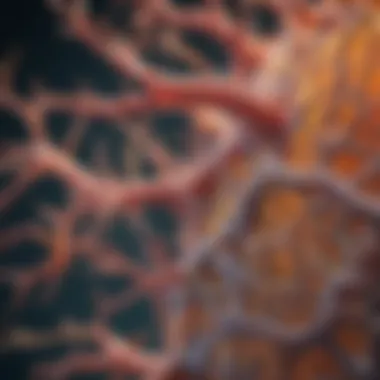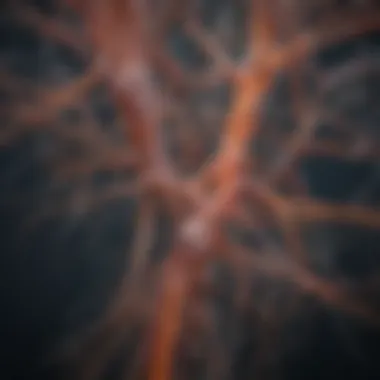Amyloid Plaques and Tangles: Insights into Neurodegeneration


Intro
Amyloid plaques and neurofibrillary tangles are among the hallmarks of neurodegenerative diseases, most notably Alzheimer's disease. Understanding their formation and implications is crucial not only for researchers but also for students and professionals in the field of neuroscience. The abnormal accumulation of amyloid-beta peptides leads to plaque formation. Meanwhile, the aggregation of tau protein contributes to the development of neurofibrillary tangles. Both pathological changes disrupt neuronal function and communication, resulting in cognitive decline.
This article intends to elaborate on the biochemical properties and the processes associated with amyloid plaques and neurofibrillary tangles. Additionally, it will discuss their connections to clinical symptoms, providing a broad overview of current research methodologies applied to study these structures.
Research Overview
The investigation into amyloid plaques and neurofibrillary tangles encompasses a variety of research approaches. Scientists utilize methods that range from molecular biology techniques to neuroimaging tools, each contributing unique insights into their nature.
Methodological Approaches
- Biochemical Analysis: Researchers often conduct biochemical assays to measure the concentrations of amyloid-beta and tau proteins in biological samples. These assays help determine their roles in disease progression.
- Imaging Techniques: Techniques such as Positron Emission Tomography (PET) allow scientists to visualize amyloid plaques in vivo. This non-invasive method provides real-time information about plaque accumulation over time.
- Genetic Studies: Examining genetic predispositions can also shed light on the processes of plaque and tangle formation. Certain genetic variations have been associated with increased risk for developing Alzheimer's disease.
- Animal Models: Animal models, specifically transgenic mice, provide a platform to study the effects of amyloid plaques and neurofibrillary tangles. These models mimic human disease pathology, enabling researchers to assess potential therapeutic interventions.
Significance and Implications
Understanding amyloid plaques and neurofibrillary tangles has significant implications. Their formation is closely linked to neurodegeneration and cognitive decline. By unraveling the biochemical pathways involved, scientists can identify potential therapeutic targets. Here are some key implications for treatment:
- Targeted Drug Development: Medications targeting amyloid-beta or tau pathology may slow disease progression.
- Biomarkers for Diagnosis: Identifying reliable biomarkers related to these structures could enhance early detection of Alzheimer's disease.
"Early detection and management of Alzheimer's disease might improve patient outcomes significantly."
- Personalized Medicine: Tailoring treatments based on an individual’s specific pathology could enhance therapeutic efficacy.
Current Trends in Science
Research on amyloid plaques and neurofibrillary tangles is continuously evolving. New techniques and interdisciplinary approaches provide a better understanding of these critical components of neurodegenerative diseases.
Innovative Techniques and Tools
Recent advancements in imaging technologies are paving the way for more nuanced investigations. For example, ultra-high-resolution MRI scans provide greater detail in assessing brain changes associated with plaque and tangle formation. Machine learning is becoming a vital tool for analyzing large datasets related to protein interactions and neurodegeneration.
Interdisciplinary Connections
The study of amyloid plaques and neurofibrillary tangles involves various fields, including molecular biology, genetics, and neurology. This interdisciplinary approach fosters collaboration among scientists, enhancing the breadth and depth of research. Insights from related areas, such as biochemistry and computational modeling, are also increasingly integrated into research efforts.
Foreword to Neurodegenerative Diseases
Neurodegenerative diseases are a group of disorders characterized by the progressive degeneration of the structure and function of the nervous system. This article discusses their significance in understanding amyloid plaques and neurofibrillary tangles. These are critical features observed in conditions like Alzheimer's disease, which represents a major focus within neurodegenerative research. Understanding these diseases is essential not only for medical practitioners but also for researchers aiming to devise effective therapeutic strategies.
Definition and Types
Neurodegenerative diseases encompass a variety of conditions that lead to neuron damage over time. The most recognized include:
- Alzheimer’s Disease: Marked by memory loss and cognitive decline.
- Parkinson’s Disease: Characterized by tremors and difficulty in movement.
- Huntington’s Disease: Involves movement disorders and cognitive decline.
- Amyotrophic Lateral Sclerosis (ALS): Primarily affects motor neurons, leading to muscle weakness.
Each condition manifests with distinct symptoms and progression rates, but they share common mechanisms involving protein misfolding and accumulation, particularly amyloid plaques and neurofibrillary tangles.
Prevalence and Impact
The prevalence of neurodegenerative diseases has reached alarming levels, driven by increasing life expectancy and aging populations. For instance, Alzheimer's alone affects millions globally. It is projected that by 2050, the number of Alzheimer's patients will reach 13 million in the United States alone.
The impact includes not only health deterioration but also significant social and economic burdens. Families often become caregivers, leading to emotional and financial strains. Healthcare systems face challenges related to long-term care, research, and therapeutic developments.
"Neurodegenerative diseases have profound implications not only on affected individuals but also on families and healthcare systems as a whole."


As scientific communities grapple with these challenges, understanding the core pathological elements like amyloid plaques and neurofibrillary tangles becomes increasingly crucial. This knowledge aids in the pursuit of innovative approaches for prevention and treatment.
Overview of Amyloid Plaques
Amyloid plaques are significant markers in the study of neurodegenerative diseases, particularly Alzheimer's disease. Their understanding is essential for elucidating the mechanisms behind cognitive decline and neuronal degeneration. This section examines their composition, formation, and role in pathologies.
Composition and Structure
Amyloid plaques are primarily composed of amyloid-beta peptides, which are derived from the amyloid precursor protein (APP). These peptides aggregate to form insoluble fibrils that are deposited in the extracellular space of neurons. The structure of these plaques can vary from small, diffuse aggregates to larger, dense cores. Amino acid sequences and specific folding patterns contribute to their stability. The formation of these uneven deposits plays a crucial role in impairing neuronal function and signaling.
Formation and Accumulation
The process of amyloid plaque formation is complex and involves multiple steps. Initially, APP undergoes enzymatic cleavage by beta-secretase and gamma-secretase, producing amyloid-beta peptides of varying lengths, most notably the 40- and 42-amino-acid forms. The accumulation of these peptides results from an imbalance between production and clearance. Factors such as genetic predispositions, age, and neuroinflammatory responses can exacerbate this accumulation. Research shows that the presence of amyloid plaques correlates with synaptic loss and cognitive deficits, underlining their pathological significance.
Role in Alzheimer's Disease
In the context of Alzheimer's disease, amyloid plaques are considered one of the hallmark features. They disrupt cell-to-cell communication and induce neuroinflammatory responses, which can further damage surrounding neurons. Studies reveal that the presence of amyloid plaques often precedes clinical symptoms, indicating their potential role in early disease detection. Moreover, the evolving hypothesis of amyloid's role suggests that it may not only be a mere byproduct of the disease but may also actively contribute to neurodegeneration. Understanding this relationship can have profound implications for developing targeted therapies and interventions aimed at mitigating the impact of amyloid plaques in affected individuals.
"Amyloid plaques serve as indicators in Alzheimer’s, revealing a broader picture of disease mechanisms."
Through comprehending the nuances of amyloid plaques, researchers can better understand neurodegenerative processes, ultimately guiding therapeutic approaches focused on these deleterious formations.
Neurofibrillary Tangles Explained
Neurofibrillary tangles are a key component in understanding neurodegenerative diseases, especially Alzheimer’s disease. These tangles are intracellular aggregations that disrupt normal neuronal function. Their presence raises significant concerns about cognitive decline and overall neural health. This section examines the characterization of these tangles, mechanisms of formation, and their pathological consequences.
Characterization of Tangles
Neurofibrillary tangles primarily consist of hyperphosphorylated tau protein. This protein, when functioning normally, stabilizes microtubules, aiding in the transport of nutrients and other substances within neurons. However, under certain conditions, tau undergoes abnormal modifications, leading to its aggregation.
The tangles appear as paired helical filaments when observed under an electron microscope. This characteristic structure makes them distinct from other pathological features in neurodegenerative diseases. The density and distribution of these tangles within the brain correlate with the severity of Alzheimer’s disease and other forms of dementia.
Mechanisms of Formation
Tangles form through a multi-step process involving both biochemical and cellular pathways. Initially, tau protein becomes hyperphosphorylated due to various factors, such as oxidative stress or amyloid beta accumulation. Once hyperphosphorylated, tau loses its ability to bind effectively to microtubules.
Subsequent aggregation leads to the formation of insoluble filaments. As these tangles accumulate, they obstruct neuronal processes critical for cell survival. Recent studies suggest that neuroinflammation and impaired autophagy contribute to the progression of tau pathology, emphasizing several potential therapeutic targets.
Pathological Consequences
The accumulation of neurofibrillary tangles produces significant pathological effects on the affected neurons. They disrupt the intracellular transport system, leading to a range of dysfunctions. Affected neurons may undergo degeneration, leading to synaptic loss and eventual cell death. This degeneration is one of the primary processes contributing to cognitive impairments in Alzheimer's disease.
The presence of neurofibrillary tangles is often found to be correlated with the degree of dementia, making them a crucial focus in both diagnosis and research for neurodegenerative diseases.
In summary, understanding neurofibrillary tangles provides insights into the underlying mechanisms of neurodegenerative diseases. Their formation and impact on neuronal health are essential for developing new therapeutic strategies aimed at mitigating cognitive decline. As research progresses, it is critical to examine both the physiological roles of tau and its pathological transitions.
Molecular Pathways Involved
The examination of molecular pathways involved in the development of amyloid plaques and neurofibrillary tangles is crucial to understand neurodegenerative diseases. These pathways not only elucidate the mechanism behind the formation of these pathological structures but also help in identifying potential therapeutic targets. Insights gained from this area of research suggest ways to intervene in the disease process, offering hope for treatment options.
Amyloid Precursor Protein Processing
Amyloid precursor protein (APP) processing has received considerable attention in neurodegenerative research. This protein is a transmembrane protein, and its cleavage product can lead to the formation of amyloid-beta peptides. The central pathway in this process includes two major enzymatic reactions: the non-amyloidogenic pathway and the amyloidogenic pathway. In the non-amyloidogenic pathway, APP is cleaved by alpha-secretase, resulting in non-pathogenic fragments. In contrast, the amyloidogenic pathway involves cleaving by beta and gamma-secretases, leading to amyloid-beta aggregation. This accumulation is a hallmark of Alzheimer’s disease.
Disruptions in APP processing potentially lead to an increase in amyloid-beta levels, thus aggravating plaque formation. The ratio between these pathways can be influenced by various factors, including genetic predisposition, biochemical interactions, and cellular conditions. Moreover, the endosomal/lysosomal pathways are essential to APP metabolism. If these pathways are impaired, the risk of amyloid plaques forming rises, correlating with the neurodegenerative process. Hence, investigating APP processing provides insights into how to modify its pathway for therapeutic alleviation of amyloid pathology.
Tau Protein and Its Role


The tau protein is integral to neuronal stability, primarily by promoting the assembly of microtubules, which are vital for maintaining the structure of axons and for intracellular transport. However, in Alzheimer’s disease, tau undergoes hyperphosphorylation, leading to its aggregation into neurofibrillary tangles. These tangles disrupt neuronal function and contribute significantly to neuronal cell death.
Several kinases and phosphatases modulate tau phosphorylation. The balance between these enzymes influences tau's ability to stabilize microtubules. In pathological states, dysregulation leads to increased tau aggregation and subsequent tangles. Notably, tau pathology has been observed to correlate strongly with cognitive decline in patients.
Understanding tau protein dynamics is important for developing treatments that focus not only on amyloid plaques but also on tau pathology. Therapies aiming to inhibit tau hyperphosphorylation or promote the clearance of tangles could represent significant advancements in combating neurodegenerative diseases.
The relationship between amyloid plaques and neurofibrillary tangles is complex. Researchers continue to explore the interconnected pathways to design effective interventions.
Analyzing the molecular pathways related to amyloid precursor protein processing and tau protein activity reveals the intricate mechanisms at play in neurodegenerative conditions. By shedding light on these aspects, the field may find new approaches for diagnosis and treatment.
Clinical Implications
Understanding the clinical implications of amyloid plaques and neurofibrillary tangles is essential for furthering our knowledge of neurodegenerative diseases like Alzheimer's. The presence of these pathological features is not merely a finding in post-mortem studies; rather, they have significant repercussions on patient care, treatment options, and the overall management of these ailments. By exploring the correlations of these structures with cognitive decline and their role in diagnostics, we can better inform future therapeutic strategies.
Correlation with Cognitive Decline
The presence of amyloid plaques and neurofibrillary tangles has been correlated with various degrees of cognitive decline. Research indicates that these aggregates disrupt normal neuronal function, leading to synaptic failure and eventual neuronal death. Notably, studies have shown that higher levels of amyloid burden often correlate with worsening cognitive abilities.
As the amyloid levels increase, patients demonstrate a steeper decline in memory and executive function. 2. Conversely, tau tangles are more closely linked with the severity of cognitive impairment, providing insights into the timeline of neurodegeneration.
One important point is the asymptomatic phase. Patients may exhibit significant amyloid accumulation without evident cognitive issues. This finding emphasizes the need for early identification of these biomarkers to prevent or slow the progression of symptoms, potentially reshaping therapeutic approaches.
Diagnostic Significance
The diagnostic significance of amyloid plaques and neurofibrillary tangles cannot be overstated. Advanced imaging techniques such as positron emission tomography (PET) allow for the visualization of amyloid deposition in living patients. The detection of plaques and tangles serves as a critical indicator for diagnosing Alzheimer's disease at an earlier stage.
- The use of cerebrospinal fluid (CSF) biomarkers can also provide essential information about tau and amyloid levels, particularly in ambiguous cases.
- Early and accurate diagnosis enables clinicians to tailor management strategies, which might include pharmacological interventions or lifestyle modifications aimed at delaying disease onset and improving quality of life.
Recognizing the significance of amyloid plaques and neurofibrillary tangles in diagnostics elevates our understanding of neurodegenerative diseases and aids in the development of targeted therapies.
Identifying these biomarkers is an ongoing area of research. The potential to develop specific treatments based on the individual’s amyloid and tau status marks a promising frontier in personalized medicine. In summary, understanding the clinical implications of amyloid plaques and neurofibrillary tangles is a vital component in the fight against neurodegenerative conditions, offering insights that can enhance both diagnosis and treatment.
Current Research Trends
Research on amyloid plaques and neurofibrillary tangles has evolved significantly in recent years. Scientists are now employing advanced techniques to better understand the complexities of neurodegenerative diseases. This section explores the latest trends in this research, emphasizing innovative imaging techniques and the development of biomarkers. Both areas are crucial for improving diagnosis and identifying potential therapeutic targets.
Innovative Imaging Techniques
Innovative imaging techniques such as positron emission tomography (PET) and magnetic resonance imaging (MRI) have drastically improved our ability to visualize amyloid plaques and neurofibrillary tangles in vivo. These non-invasive methods allow researchers to study the progression of Alzheimer's disease in real-time, providing insights into how these pathologies correlate with cognitive decline.
- Positron Emission Tomography (PET): This imaging technique enables the observation of amyloid deposits using specific radioligands. Researchers use substances like Pittsburgh Compound B (PiB) to detect amyloid accumulation in the brain, facilitating early diagnosis of Alzheimer's.
- Magnetic Resonance Imaging (MRI): Advanced MRI techniques can identify structural changes in the brain associated with neurodegeneration. Functional MRI (fMRI) can also observe changes in brain activity related to the presence of these pathologies.
The ability to visualize these features enhances our understanding of their role in disease mechanisms. Early detection of amyloid and tau pathology can guide therapy decisions and patient management strategies.
Biomarker Development
The identification and development of biomarkers are crucial for diagnosing and monitoring neurodegenerative diseases. Biomarkers can provide objective measures of disease progression and treatment response.
- Biomarkers for Amyloid and Tau: Researchers are focusing on blood and cerebrospinal fluid (CSF) biomarkers that reflect brain pathology. For example, the measurement of amyloid-beta and tau proteins in CSF can indicate the presence of Alzheimer's disease.
- Emerging Biomarkers: Novel biomarkers are continuously being studied. For instance, neurofilament light chain (NfL) has emerged as a promising marker for neurodegeneration in several studies. It is showing potential not only for diagnosing Alzheimer's but also for tracking disease progression across various neurodegenerative disorders.
"The advancement in biomarker discovery is crucial for clinical trials and developing targeted therapies. As more reliable markers are identified, we can translate findings into improved patient outcomes." — Research Scientist
Therapeutic Strategies
In the pursuit of effective interventions for neurodegenerative diseases, particularly Alzheimer's disease, therapeutic strategies aimed at amyloid plaques and neurofibrillary tangles have taken center stage. These strategies focus on alleviating the burden of these pathological features by employing a range of pharmacological and non-pharmacological approaches. The challenge lies not just in mitigating symptoms but in addressing the underlying mechanisms responsible for the formation and accumulation of these detrimental structures in the brain. As researchers delve into these strategies, several key elements emerge that are crucial for the development of effective treatments.


Targeting Amyloid Deposits
Targeting amyloid deposits primarily involves the use of amyloid-targeting agents that can disrupt the formation of amyloid plaques or enhance their clearance from the brain. A prominent example of this approach includes the administration of monoclonal antibodies, such as Aducanumab and Lecanemab. These antibodies specifically bind to amyloid-beta aggregates, prompting the immune system to eliminate them. The concept behind this strategy stems from studies indicating a strong correlation between amyloid plaque presence and cognitive decline in individuals affected by Alzheimer's disease.
The benefits are tangible. The reduction of amyloid plaques has been associated with slowed disease progression and improved cognitive functions in some clinical trials. However, this approach is not without its challenges. The heterogeneity of amyloid pathology across individuals complicates treatment. Moreover, issues such as brain edema and other adverse effects have surfaced in response to amyloid-targeting therapies, raising questions regarding long-term outcomes and safety.
Modulating Tau Pathology
Modulating tau pathology is increasingly viewed as a complementary strategy. This approach recognizes that tau tangles contribute significantly to neurodegeneration. Attempting to stabilize tau or decrease its hyperphosphorylation can be an effective strategy. One prominent treatment type involves the use of tau aggregation inhibitors, which aim to prevent the formation of tangles. Other strategies may focus on enhancing tau degradation processes through cellular mechanisms.
The potential advantages of modulating tau pathology include preserving neuronal function and reducing cognitive decline. Medications like LMTX have been researched for their potential to reduce tau pathology, although results vary significantly across different trials.
Challenges also exist in this area, primarily regarding the specificity and efficacy of tau-targeted treatments. Moreover, the timing of intervention appears critical; initiating treatment at the earliest stages of tau pathology might yield better outcomes compared to later interventions.
"The interplay between amyloid plaques and tau tangles presents a complex landscape that requires a multi-faceted approach to treatment."
In summary, therapeutic strategies focusing on amyloid deposits and tau pathology highlight the necessity for a dual approach in addressing the multifactorial aspects of Alzheimer’s disease. As research progresses, the hope is to not only halt disease progression but to enhance the overall quality of life for those affected.
Future Directions in Research
The exploration into amyloid plaques and neurofibrillary tangles continues to evolve. Ongoing research plays a crucial role in understanding these pathological features and their implications for neurodegenerative diseases. Emerging technologies and methodologies are opening new avenues for investigation. This section discusses future directions that hold promise for enhancing our understanding of these structures.
Longitudinal Studies and Cohort Analysis
Longitudinal studies are essential for observing the progression of neurodegenerative diseases over time. Cohort analysis allows researchers to track changes in individuals as they age. This approach provides valuable insights into how amyloid plaques and neurofibrillary tangles develop and affect cognitive functions. For example, identifying at what stage these structures begin to appear can lead to early intervention strategies.
Key points about longitudinal studies include:
- They enable the identification of risk factors that might contribute to the formation of plaques and tangles.
- Tracking a large group over years helps in understanding the variability in disease progression.
- Data collected can inform the efficacy of potential therapeutic interventions.
"Longitudinal studies pave the way for understanding not just what happens, but when and why it happens in neurodegeneration."
Gaps and Challenges Ahead
Despite advancements, challenges remain in research practices. There are significant gaps in knowledge about the exact mechanisms through which amyloid plaques and neurofibrillary tangles influence neurodegenerative processes. These gaps must be addressed to develop effective strategies for diagnosis and treatment.
Some of the gaps and challenges include:
- Understanding Early Biomarkers: Identifying early indicators of disease is critical, yet many studies still find it difficult to pinpoint these biomarkers effectively.
- Clinical Variability: Individual responses to similar pathological presentations vary, making it challenging to establish standardized treatment protocols.
- Technology Limitation: While imaging and biomarker discovery are improving, the tools still have limitations in sensitivity and specificity when it comes to early detection.
Research must focus on filling these gaps to enhance our understanding of neurodegenerative diseases. Collaborative efforts among researchers, clinicians, and technologists will be vital in overcoming these challenges.
As the field progresses, ongoing dialogue around these areas will ensure that future research is directed meaningfully, yielding insights that can inform better clinical practices.
The End
Summation of Findings
The investigation into amyloid plaques and neurofibrillary tangles reveals critical insights:
- Formation Processes: Amyloid plaques result from the aggregation of beta-amyloid peptides, while neurofibrillary tangles are formed by the hyperphosphorylation of tau proteins.
- Pathophysiological Role: Both structures are implicated in the disruption of neuronal function and integrity, leading to synaptic failure and eventually cell death.
- Clinical Correlation: Numerous studies have shown a correlation between the presence of these aggregates and the severity of cognitive impairment in patients, emphasizing their potential as biomarkers for Alzheimer's disease.
These findings underline the significance of ongoing research into effective detection methods and potential therapeutic agents targeting these deleterious formations.
Implications for the Future
The study of amyloid plaques and neurofibrillary tangles carries profound implications for future research and treatment strategies:
- Innovative Treatment Approaches: Research may prioritize the development of drugs aimed specifically at preventing plaque formation or tau aggregation. This could lead to groundbreaking therapies that slow, halt, or even reverse neurodegeneration.
- Diagnostic Techniques: Advances in imaging technologies could enhance early diagnosis, allowing for timely intervention and personalized treatment plans, potentially improving outcomes for patients.
- Expanding Research Areas: Understanding the interplay between these two factors could lead to new pathways in neurobiology, forming foundations for future studies on other neurodegenerative disorders.
"The pursuit of knowledge regarding amyloid plaques and neurofibrillary tangles not only sheds light on Alzheimer's disease but also opens avenues for therapeutic strategies in various neurodegenerative conditions."
The implications of this knowledge are significant, not just for current understanding but for shaping future research agendas aimed at improving health outcomes in neurodegenerative diseases.



